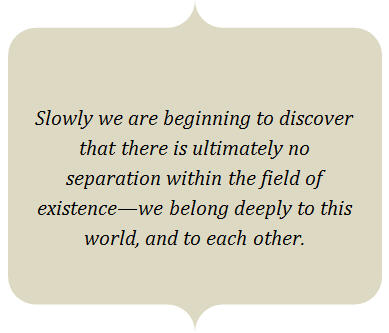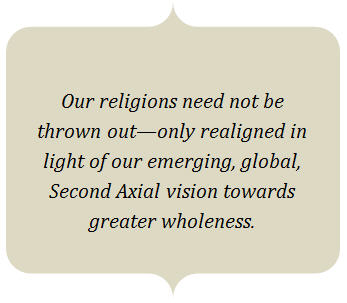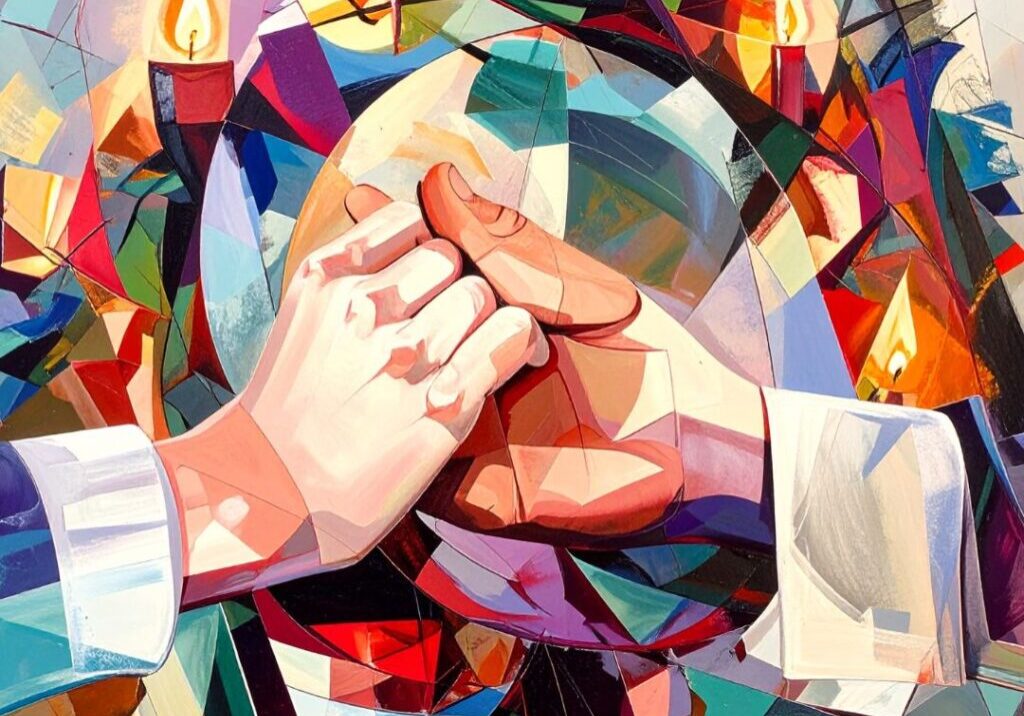The Second Axial Emergence
The religious landscape is shifting—no one will argue with that. People are leaving traditional religious frameworks in droves, while the number of those identifying as “spiritual but not religious” (SBNR) is on the rise. While some of the religious faithful decry this shift as inherently negative, I believe there’s a framing in which we can see it not only as a hopeful sign for the human family, but for our religious traditions as well.
The twentieth-century philosopher Karl Jaspers coined the notion of the “Axial Age”—a window of time that fell roughly between 800 and 200 BCE.1 It’s the period of human history during which the headwaters of all our great religious traditions began to form, seemingly independently around the globe: Lao Tzu taught the way of the Tao in China; the seers of the Upanishads were busy realizing the Self in India; the Hebrew prophets preached social justice and monotheism in Israel; the early Greek philosophers emerged; the Buddha had his great awakening. A planetary shift in spiritual understanding was underway.
Until this shift, human spirituality had been largely earth-based, and our original gods were found in the cycles, seasons, and forces of nature. Fertility rites were celebrated; the Divine Feminine was honored; and identity was primarily collective, held in the tribe over and above the individual. With this Axial shift, however, human spirituality opened to the possibility of the transcendent, and the adventure of an individual spiritual quest for salvation or enlightenment began. Siddhartha left his wife and child in the palace as he set off on the path that would make him the Buddha; Abraham and Sarah left behind tribe and tribal gods to follow the One God.
Axial spirituality began breaking ties in a profound way with both collective identity and with the Earth. At the same time, with the new emphasis on the individual and the transcendent, the models of salvation or enlightenment that emerged began to look a lot like escape. A profound sense that something was wrong with this world began to dominate the spiritual landscape—whether it was understood as fallenness and sin in the West, or suffering and samsara in the East. Something was wrong, and the ultimate goal was to get out of here—to attain to the heavenly prize or to escape the cycle of death and rebirth. This sense of exile has been a deep undercurrent in human spirituality ever since.
 But today the picture is shifting again. Today more than ever we have a profound sense of the interconnection of all life—and you don’t need to be a “mystic” to get this. The truth of interconnection is pouring in from every field of knowledge: from environmentalists, recognizing that we are part of a global ecosystem; to quantum physicists, uncovering the deep interconnection at the most subtle levels of matter; to evolutionary biologists, revealing life’s unfolding as a single, vast process. Not to mention the internet and smart phones, which are interweaving the world at the level of communication. Slowly we are beginning to discover that there is ultimately no separation within the field of existence—we belong deeply to this world, and to each other.2
But today the picture is shifting again. Today more than ever we have a profound sense of the interconnection of all life—and you don’t need to be a “mystic” to get this. The truth of interconnection is pouring in from every field of knowledge: from environmentalists, recognizing that we are part of a global ecosystem; to quantum physicists, uncovering the deep interconnection at the most subtle levels of matter; to evolutionary biologists, revealing life’s unfolding as a single, vast process. Not to mention the internet and smart phones, which are interweaving the world at the level of communication. Slowly we are beginning to discover that there is ultimately no separation within the field of existence—we belong deeply to this world, and to each other.2
With the emergence of this new, global, interconnected awareness, many thinkers are telling us that we are now entering a Second Axial Age—another great, global shift in consciousness equal in weight and importance to that first great shift that produced our existing religious traditions.3 And religion and spirituality are being transformed all over again.
With this second shift, we are picking up everything we lost in that first great Axial transformation—the profound earthiness and connection to our bodies and a deep sense of collective identity. But we are not picking them back up at the tribal level; we are picking them up at the global level. We are one tribe, one human family, one planet Earth.
At the same time, we are not losing our appreciation of the individual, the transcendent, and the rational that we have cultivated over the last two thousand years; rather, we are integrating it with an appreciation of the collective, the immanent, and the intuitive, now bound together in a global vision big enough for the entire human family. The “Second Axial Age” is about the marriage of heaven and earth, the immanent and the transcendent, spirit and body, time and eternity.
In this light, we discover that what was originally felt as a sense of exile is actually the surest sign that we belong to this world—the evolutionary impulse, not to escape, but to serve the work of driving the world forward in its process of becoming. Our ancestors may have believed they were opening to the transcendent in order to leave the world behind. Instead, our discovery is that we open to the transcendent so that it may more fully flow into, inform, and evolve this world.
And so, again, salvation, enlightenment, awakening, all begin to look a little different. We realize that we can’t leave this Earth or our bodies or each other behind in the process. We will either awaken together, hand in hand, or not at all.
Now enter into the spiritual landscape the “Nones” and “SBNRs” who have left traditional religious forms behind. These are by-and-large members of the younger generations who themselves were born into a globally interconnected world. The old lines and boundaries do not make much sense to this new batch of human beings. And yet, they are offered religious systems that often reinforce separation, division, and a world-denying spirituality. Of course they are rejecting them.
But here, I believe, is the good news: we do not have to craft Second Axial religions from scratch. The stirrings of the Second Axial impulse are already present in our spiritual lineages. For the longest time, scholars have simply lumped Christianity and Islam in with our First Axial religions, even though they were formed well after Jasper’s Axial window of 800-200 BCE. I would suggest that, instead, we can see them—along with currents emerging in the other traditions as well—as the first stirrings of Second Axial awareness.
Christianity has always rested uneasily with our First Axial roadmaps, although again and again it has been roped back into them. But enshrined in that most basic doctrine of the Incarnation is a profound embrace of the phenomenal world: “For God so loved the world” that “the Word became flesh.” Here we see a profound sense of divinity in matter and form, and a downward movement of Spirit towards “the world” rather than an upward escape from it.
And while many contemporary Christians speak about their “personal Lord and Savior,” the New Testament image is largely one of collective awakening—an emerging, expanding, organic Body of Christ that individuals are incorporated into. St. Paul spoke of the whole creation “groaning in labor pains” as it struggles towards the “revealing of the children of God” (Romans 8:22). We see present in texts like this a sense that not only is the manifest world good (and therefore not to be escaped or rejected), but also that it is moving forward toward a new, higher-level collectivity.
We see a similar understanding emerging at almost the same time in Mahayana Buddhism with the rise of the Bodhisattva vow. Here, the Buddhist ideal shifted away from individual enlightenment and extinguishment in Nirvana towards a pledge to forswear one’s own final liberation in order to remain in the phenomenal world working for the collective awakening of all beings.
A few centuries later with the rise of Islam, a similar integrative impulse is at work. Islam took the rhythm of monastic prayer and offered it in the marketplace, while Sufism, Islam’s mystical tradition (based as it was on the life of a prophet who was a husband, parent, and statesman), found it practically impossible to give way to the First Axial impulse toward ascetical extremes; instead, the Sufis pledged to keep the contemplative life fully integrated into the life of the world.
In all of these examples, we see the early stirrings of the Second Axial impulse. We’re only just now catching up with it, and setting it within its proper, global context. And so, while our religions may largely express themselves in exclusive and divisive ways, the seeds have already been sown for their own Second Axial transformations. We will need these religions to contribute the spiritual practices that can best help our species evolve and mature away from our own debilitating ego- and anthropo-centricity.  Our religions need not be thrown out—only realigned in light of our emerging, global, Second Axial vision.
Our religions need not be thrown out—only realigned in light of our emerging, global, Second Axial vision.
And so I believe there is great hope in the fact that individuals are leaving behind divisive forms of religion as they awaken to a sense of global humanity and interconnection. Initially frightening for our religious traditions, it may be just what they need to jumpstart their Second Axial possibilities and expressions. At the same time, spiritually hungry “Nones” and “SBNRs” who find themselves entering the religions while bringing expanded vision will help with this realignment. As these expressions emerge, new generations will once again be able to find the necessary nourishment that is already present in our religions, realigned for a global era.
NOTES
- Karl Jaspers, The Origin and Goal of History (Zurich: Artemis, 1949), 19-43.
- For a further exploration of these themes see Beverly Lanzetta’s Emerging Heart: Global Spirituality and the Sacred (Minneapolis, MN: Fortress Press, 2007).
- Ewert Cousins was the first to suggest a “Second Axial” period in his Christ of the 21st Century (New York, NY: Continuum, 1992), 7ff.
 View print-friendly version
View print-friendly version
3 Comments
Related Posts

Rewiring Our Lives Together, the Franciscan Way
The Season of Incarnation We are in the season of Incarnation—God becoming flesh. It is a beautiful time of the year that brings out the best of humanity, even in…


Hello Mathew, and Margaret, I’m in my mid seventies
I have also been reading, and more recently attending a Seminar, on Ilea Delio’s work. What struck me in the Seminar was how “stuck” Delio seems in her Christian Viewpoint, despite her speaking of an Inter-Spritual, Inter-Faith perspective needing to be brought to the discussions. It didn’t happen. I cannot fathom Christianity, and I give my heart to that perspective from a progressive place, seeing itself as the holding the “Christ Omega” perspective above the spiritual insights of other Religions / Spiritualities. It brings me closer to joining the SBNR group who understandably, and yes, often creatively, have severed, or never given their hearts to Religions of any persuasion.
One of the presenters at the Seminar gave me your name, Mathew, to take me further into this work towards the Omega Point from a wider perspective. I am deeply grateful for your article and intend to do much more reading guided at first by your writing.
I ache at buying yet another book, that I aught to read – Beverly Lanzetta – So, at firstI’ I will read trusted Blogs
Thank you,
Jen-Beth
Hello Matthew
I am an 80 year old woman, Christian by faith, though by the grace of God, (not a trivial or trite statement) have been gifted an evolving faith into a growing vision and experience of being connected to all people and our environment and our universe.
I have also been led by the Mystics and am fortunate to belong in an area where contemplatives, retreats and meditation is flourishing alongside and within our churches.
I’ve been reading Ilia Delio’s “Christ in Evolution” and wanted to have the “Second Axial” term amplified. So my friend Mr Google was asked to provide information: your article is the most enlightening and nourishing from my understanding of Ilia’s book.
This is my first attempt at making a comment on an article so thanks for inspiring me. Hope you can get the gist of it. Sincerely Margaret Bennett
Hi all–it seemed worth dropping a comment here to the effect that these “Axial epochs” are only helpful framing devices that outline major spiritual trends or currents. It’s important to remember that human spiritual evolution is a lot more messy in actuality than these neat, clean “windows” of time might imply, and that you’ll see “Second Axial” threads in “First Axial” expressions, etc. Judaism, for example, never lost touch entirely with that pre-Axial sense of earthiness and emphasis on collective/tribal identity. So, don’t view these windows too rigidly!